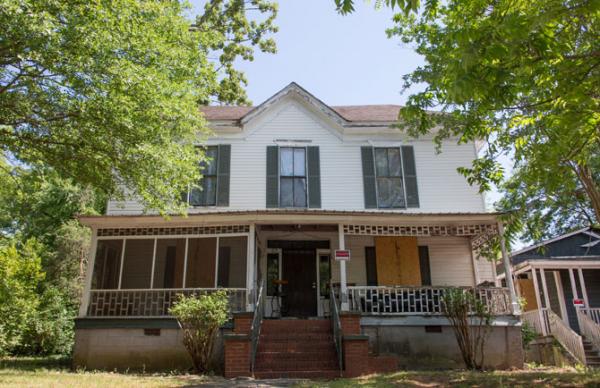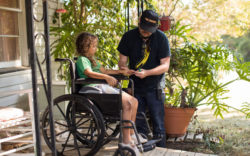Next door, Boss Billups was a Baptist minister. Down the street, Camilla and Vernon Howard were teachers. In small houses in between—some owned, some rented—lived cooks, drivers, porters and maids. They were among the many families who made the Reese Street area a thriving, middle-class black neighborhood in the early 1900s. For decades, it was a neighborhood of homeowners and entrepreneurs.
Today, in between the smaller cottages, stands a two-story house that was home to two generations of teachers and the second black dentist in Athens—a house that was slated to be torn down by the family who built the Varsity restaurant on the opposite side of the block some 50 years ago before the Athens-Clarke County Commission declared a one-year moratorium on residential demolitions in May while a plan to protect the neighborhood is worked out.
What makes the house unique isn’t just the Mack/Burney family who lived in it for nearly half a century—the same Burney for whom Burney-Harris-Lyons Middle School is named. Rather, it’s that the house represents a crossroads of Athens: the invisible lines separating black and white; lines erased between professionals and laborers to create a tight-knit community; and the color lines crossed with school desegregation.
Black Professionals
Shadows of the historically black Reese Street neighborhood remain today, but what longtime residents recall from its heyday is a tight-knit neighborhood of families who valued education and community. “I’ve lived all my life within this square,” says 92-year-old Robert P. “Skip” Payne, who lives on Rocksprings but was born in a house on Broad Street that since has been torn down. “Except for the time I was away at school or in the service, I was in this area… I guess I just felt at home.”
For more than 150 years, Reese Street and Hancock Avenue were the center of residential life for many in Athens’ black community. The portion of the neighborhood east of Milledge Avenue was designated a local historic district a decade ago—it was home to historically black schools and Hill First Baptist Church. In contrast, the streets west of Milledge have a history that’s tied more to the people who lived in the buildings, rather than the buildings themselves.
For example, in 1920, families who lived along Reese Street west of Milledge included pastors, teachers, doctors and merchants. Andrew Payne, one-half of the namesake of Mack and Payne Funeral Home and Skip Payne’s grandfather, lived at 957 Reese St.; his neighbor was a teacher. One block up lived an insurance agent, and around the corner on Billups Street lived a pastor, a baker and his wife, a doctor.
“There were a lot of teachers in this area,” Payne says, noting three couples within a stone’s throw of Reese Street that were teachers. But, he adds, if you had money to buy property, there were only so many places you could own it. “At the time we were living, we were restricted to this area. You couldn’t buy property beyond the area distinguished black. I don’t know if it was set up like that, but you knew you weren’t going to buy a house in that [white] neighborhood, that’s for sure.”
Payne, who was also a teacher, recalls attending the West Broad Street School as a child—a wood frame building that formerly was a tuberculosis hospital. When he was in sixth grade, it was torn down, replaced by the current building.
Elsewhere in the neighborhood, Ruth Payne (no relation), 90, who was the first black teacher at Athens High School before it became Clarke Central, recalls what it was like to grow up on Billups Street. “It was a village. We didn’t have crime. It was nice—even though we had a hook on the screen door, nobody hooked the screen door,” she says in an interview recorded by Amy Kissane, executive director of the Athens-Clarke Heritage Foundation, and Kimberly Davis, who is researching the neighborhood’s history. “There were a lot of teachers and professional people who lived in that area.”
Skip Payne’s grandfather’s home on Reese Street is now the annex for Ebenezer Baptist Church West. Like the Burney house one block away, there is talk of tearing down the former Payne house, to make way for a new church building. “That was the family home,” he says. “They talk about tearing it down, but it should be preserved as a historical site, because it’s one of the oldest houses.
“If you look around the neighborhood—across the street there were teachers, the Drakes’ home on one corner, the guy was an interior decorator, and on the other corner were schoolteachers. It’s a pretty prominent area up in there. But people don’t care about all that. They’ll tear all that down.”

Photo Credit: Austin Steele
From white doctors to black educators to white renters to target for redevelopment, 853 Reese St. tells the tale of Athens.
Educators Abound
One block away from the Payne home, at 853 Reese St., is the two-story home where Annie Burney grew up. Her parents, John R. and Charlotte Mack, were a middle-class black family at the start of the 20th Century. Her father bought the house in 1906 for $600 from the Clarke County Building Loan and Improvement Company, which required a weekly payment of $3.84. Mack ended up paying the loan off early, buying the house outright in 1909.
Burney was one of nine children, and she followed in her father’s footsteps by becoming a teacher as well. According to Michael Thurmond’s A Story Untold, Burney’s father taught at a school for black children on Baxter Street until 1893, when it was closed to be remodeled for white students. The black children who attended that school were split between two others, one on the east and one on the west side of town. Mack was appointed principal of the smaller East Athens school, where he was one of three teachers; the westside school became the West Broad Street School.
Mack worked alongside Samuel Harris, who became principal of the West Broad School in 1903 (and later married another educator, Judia Jackson Harris). Ten years later, the first high school for blacks, the Athens High and Industrial School, was built on Reese Street east of Milledge Avenue. According to A Story Untold, Samuel Harris became the principal there in 1917, teaching 10th grade while also supervising all the black schools in Athens. Burney worked with him, teaching eighth and ninth grade and serving as assistant principal.
“She sorta ran things anyway,” says Payne, one of Burney’s students. “She was one of those folks who runs things.”
He also remembers doing odd jobs for her when he was in high school, helping out in her big white house around the corner. Her husband, Isadore Horace Burney, was the second black dentist in Athens but died in 1938, 18 years after they were married. Their son, also named Isadore Horace, was born in 1912. “I would get coal and do little things around the house for her when she was my math teacher. It’s a great big house with lots of fireplaces,” he says. “She also took in young folks who came to Athens to teach, and she would rent rooms to them—teachers at the high school.”
Burney died on Oct. 19, 1963, after living in the house for more than 50 years. While her siblings moved out over the years, she and her husband stayed put. In her final years, Payne recalls, the Hackney family looked after Burney and, after her death, purchased the house for $10.
An Antebellum Past?
Years later, when the Hackney family sold the home, its next string of owners followed the trend of many older intown properties: turned into a rental or eyed for redevelopment. Before it was purchased by the Gordy family last year, the home was owned first by the LaFlamme family and then by John Willis, an Atlanta builder who redeveloped properties around Athens in the early 2000s.
Today, the Burney house is owned by a white family; 100 years ago, the home was owned by a black family. But 100 years before it was purchased by the Macks, the property was owned by a white family.
While property records appear inconclusive in explaining how the house came to be built, a deed from 1889 notes it was where Athens resident Rachel Neisler died. The Athens-Clarke County tax assessor—which can often be unreliable when dating homes—lists the home as built in 1870. Athens architect Scott Reed, who consults on historic homes, notes several architectural elements that could date the house as pre-Civil War.
“Athens has an interesting history with its architecture,” Reed says. “When you look beyond the Victorian elements of the house, there’s a very classic form that very well could be antebellum—there are elements of the house that could date to 1850. The form is something that would have been common of that time, and there’s a kitchen wing that would have been common between 1830–1860.”
Reed also notes, though, that it wasn’t unusual for homes to be moved, or portions of older homes used in the building of a newer one. Early maps of Athens did not include that portion of Reese Street, although the magnolia trees that line Milledge Avenue beside the Varsity parking lot were once the grand entrances to stately homes, and city directories from the late 1800s note some residences on Hancock Avenue and Reese Street west of Milledge.
One other clue points to the antebellum age of the home: The woman referenced in the 1889 deed for the Burney house is likely a descendant of Hugh Neisler, who came to Athens in the early 1800s with the distinction of being the town’s second doctor (after the previous second doctor left, according to Augustus Longstreet Hull’s Annals of Athens, because “one doctor, one lawyer, one blacksmith and one preacher were sufficient” for the time). Six months after Neisler’s heirs sold the house for $250, the new owner sold it for $175 to the Clarke County Building Loan and Improvement Company—which sold the house, 25 years later, to a black family.
Forgotten History
Athens native and activist Broderick Flanigan learned about Annie Burney when he was researching a mural he painted recently at Burney-Harris-Lyons Middle School. He had heard rumors for months that the educator’s home was slated to be torn down, but he didn’t know where it was located until the Gordy family pulled the demolition permit. Flanigan says the history lesson helped open his eyes to the amount still unknown in the local black community. The demolition permit also put pressure on the Athens-Clarke County Commission to protect the house and surrounding neighborhood with a moratorium on teardowns, which it passed in May.
“It really speaks to the highlighting of one part of Athens history and the neglect of another part, and now we’re at a point where there’s an intersection of the newcomers into the neighborhood and their ability to organize and slow down impending development,” he says, noting the gentrification that has taken place in the neighborhood in recent years. “And at the same time, there’s African-American history there that might not be able to be preserved without this other organizing effort.”
Athens resident Fred Smith, who has researched some of Athens’ black history for his Black History Bowl program for elementary students, agrees that more is needed to be done to preserve the story of black Athenians. “Now is the time for us to record who exactly lived in these houses,” he says. “I hate to see that we failed to acknowledge who these folks were and the outstanding contribution these folks made… What I am trying to do now is go over there and walk the neighborhood and talk with some folks and find out from people who have lived there.”
Saving old homes like the Burney house, with its wide floorboards and hand-built fireplaces, takes more than an interest from neighbors and other residents. It also takes money.
“It’s difficult to stop ‘progress’—if that’s what it’s called—but I love it when we are able to save something,” Smith says. “But it takes resources—and I don’t know where the resources are for those of us who would like to save those houses. In the end, it’s a capitalistic society, and money, most of the time, will rule the day. Sometimes we can have some victories, and that’s great; we should appreciate any victories we can.”
Like what you just read? Support Flagpole by making a donation today. Every dollar you give helps fund our ongoing mission to provide Athens with quality, independent journalism.









